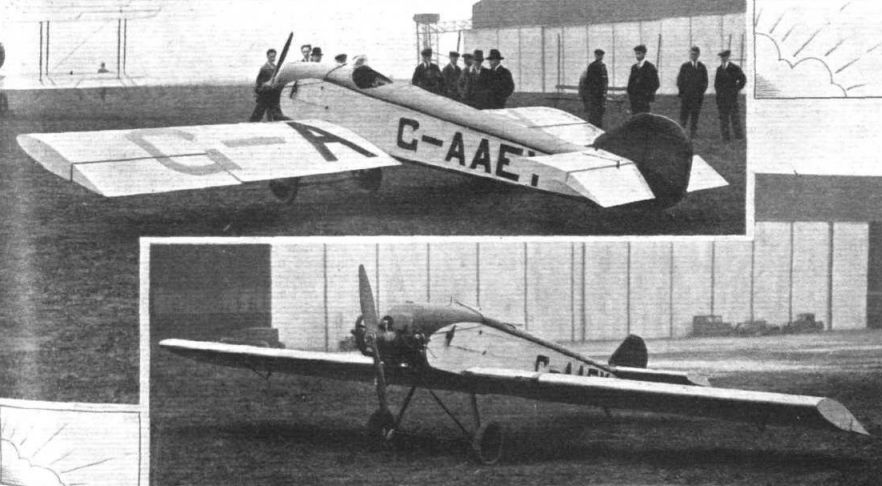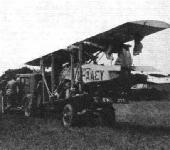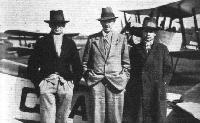
Henderson-Glenny H.S.F.II Gadfly I, II
Одноместные монопланы с открытой кабиной семейства Gadfly не отличались многочисленностью - было построено всего три машины. Первым стал H.S.F.II Gadfly I, оснащенный двигателем ABC Scorpion 2 мощностью 35 л.с. (26 кВт), который в 1929 году после установки элеронов конструкции Пирсона был переименован в Gadfly II. 16 мая 1929 года самолет установил в своем классе рекорд высоты - 3021 м. По данному проекту был построен второй самолет Gadfly II. Наконец, третий самолет, названный Gadfly III, был в целом идентичен по конструкции Gadfly II, но оснащался звездообразным двигателем Salmson A.D.9 мощностью 40 л.с. (30 кВт).
Описание:
- Henderson-Glenny H.S.F.II Gadfly I, II
- Flight, June 1929
BRITISH AIRCRAFT AT OLYMPIA
Фотографии
-
Flight 1929-05 / Flight
Регистрационный номер: G-AAEY [14] THE "MOTOR-CYCLE OF THE AIR": Two views of a new light monoplane which has just been produced by Lieut.-Col. G. L. P. Henderson (of the Henderson Flying School, Croydon). Designed by Capt. K. N. Pearson, this little machine is powered with a 40 h.p. A.B.C. "Scorpion" engine, and is of all-wood construction - even to the fuselage and wing covering. It is intended to place this machine on the market at a very moderate price.
-
Aeroplane Monthly 1976-11 / A.Ord-Hume - Henderson-Glenny H.S.F.II Gadfly /British pre-war ultralights/
Регистрационный номер: G-AAEY [14] The aircraft is seen at Brooklands in its original form with conventional ailerons.
-
Мировая Авиация 156
Регистрационный номер: G-AAEY [14] Эта машина с регистрационным номером G-AAEY стала единственным самолетом типа H.S.F.II Gadfly I.
GADFLY AT BROOKLANDS, with the old racing track in the background, G-AAEY was the first prototype of the Henderson & Glenny H.S.F. II - a single-seat ultra-light powered by a 40-h.p. ABC Scorpion. A second Gadfly, G-AARK had a 40-h.p. Salmson motor. Other 1929 British ultra-light contemporaries included: the A.B.C. (Motors) Robin (G-AAID); Nick Comper's C.L.A.7 Swift (G-AARX; 40-h.p. Scorpion) and the Hendy 281 Hobo (G-AAIG; Scorpion). Gadfly (Scorpion); 91 m.p.h. at a.u.w. 750 lb. Span 25 ft. 10 in.;
length 17 ft. 10in. -
Flight 1930-05 / Flight
Регистрационный номер: G-AAEY [14] DIGNITY AND IMPUDENCE: The Gadfly goes to bed beneath the nose of the Inflexible!
Другие самолёты на фотографии: Beardmore Inflexible - Великобритания - 1928
-
Aeroplane Monthly 1990-03 / P.Jarrett - Beardmore's heavy metal monsters (2)
Регистрационный номер: G-AAEY [14] The Inflexible al Conington in June 1929 with Glenny and Henderson Gadfly G-AAEY nestling under its nose. The Gadfly's empty weight was 17 per cent of that of the Inflexible!
Другие самолёты на фотографии: Beardmore Inflexible - Великобритания - 1928
-
Flight 1929-06 / Flight
Регистрационный номер: G-AAEY [14] The Henderson Glenny single-seater monoplane (A.B.C. "Scorpion") arriving at Conington. It was assembled and flown in remarkable time.
-
Flight 1929-05 / Flight
Регистрационный номер: G-AAEY [14] A Good Beginning: The little single-seater monoplane with A.B.C. "Scorpion" engine, produced by Henderson and Glenny, and to which we referred recently, established a world's record last week by reaching a height of 10,400 ft. (uncorrected), piloted by Col. Henderson. Standing in front of the machine are, from left to right, Col. G. L. P. Henderson, Mr. K. N. Pearson (designer), and Mr. Glenny. Experiments are to be made shortly with wings fitted with the Pearson type of lateral control.
-
Мировая Авиация 156
Регистрационный номер: G-AAEY [14] На фотографии - H.S.F.1 и Gadfly I. Конструктор обоих самолетов подполковник Хендерсон погиб в катастрофе в 1930 году.
Другие самолёты на фотографии: Henderson HSF.1 - Великобритания - 1928
-
Aeroplane Monthly 1976-11 / A.Ord-Hume - Henderson-Glenny H.S.F.II Gadfly /British pre-war ultralights/
Регистрационный номер: G-AAEY [14] A close-up of the 35 h.p. ABC Scorpion installation and external elevator cables in G-AAEY
-
Aeroplane Monthly 1976-11 / A.Ord-Hume - Henderson-Glenny H.S.F.II Gadfly /British pre-war ultralights/
Регистрационный номер: G-AARK Glenny flies the third and last Gadfly, G-AARK with a 40 h.p. Salmson radial engine, beneath the bridge over the Brooklands racetrack. In this picture it has conventional ailerons.
-
Aeroplane Monthly 1976-11 / A.Ord-Hume - Henderson-Glenny H.S.F.II Gadfly /British pre-war ultralights/
Регистрационный номер: G-AARJ [2], CF-AMG [2] G-AARJ as it looked when intact.
-
Flight 1929-07 / Flight
Регистрационный номер: G-AAEY [14] GLENNY & HENDERSON "GADFLY" (A.B.C. "Scorpion").
-
Aeroplane Monthly 1976-11 / A.Ord-Hume - Henderson-Glenny H.S.F.II Gadfly /British pre-war ultralights/
Регистрационный номер: G-AAEY [14] A. P. Glenny flying the first Gadfly, G-AAEY, for the benefit of Flight’s photographer, after the fitment of the new wing featuring Capt Pearson’s "oyster” ailerons.
-
Aeroplane Monthly 1976-11 / A.Ord-Hume - Henderson-Glenny H.S.F.II Gadfly /British pre-war ultralights/
Регистрационный номер: G-AAEY [14] -
Aeroplane Monthly 1976-11 / A.Ord-Hume - Henderson-Glenny H.S.F.II Gadfly /British pre-war ultralights/
Регистрационный номер: G-AAEY [14] G-AAEY, depicted in the air-to-air shot.
-
Flight 1929-07 / Flight
Регистрационный номер: G-AAEY [14] The Glenny and Henderson "Gadfly" is a single-seater light 'plane. It is fitted with Pearson Rotary Ailerons.
-
Aeroplane Monthly 1976-11 / A.Ord-Hume - Henderson-Glenny H.S.F.II Gadfly /British pre-war ultralights/
Регистрационный номер: CF-AMG [2], G-AARJ [2] G-AARJ went to Canada in 1930, where it enjoyed a brief life as CF-AMG. It is seen below at Hamilton, Ontario, still with rotary ailerons.
-
Flight 1929-07 / Flight
Cockpit and luggage compartment (with lid open) of the Glenny & Henderson "Gadfly" single-seater light 'plane.
-
Aeroplane Monthly 1976-11 / A.Ord-Hume - Henderson-Glenny H.S.F.II Gadfly /British pre-war ultralights/
Glenny contemplates his narrow escape from Gadfly Mk II G-AARJ, following the unhappy "landing” at Wargrave on Thames.
-
Flight 1929-07 / Flight
An ingenious differential control is used in the "Gadfly." Normal position shown in full lines, and maximum control position in dotted.
-
Flight 1929-07 / Flight
From the joy stick tubes run to a crank on a pulley, and thence the rotary aileron is operated by cable in the "Gadfly."
-
Flight 1929-07 / Flight
Pin attachment of main wing spar to fuselage in "Gadfly."
-
Flight 1929-07 / Flight
The rotary ailerons on the "Gadfly" shown in normal and maximum position.
-
Flight 1929-07 / Flight
Glenny & Henderson "Gadfly" A.B.C. "Scorpion" Engine
- Фотографии
























